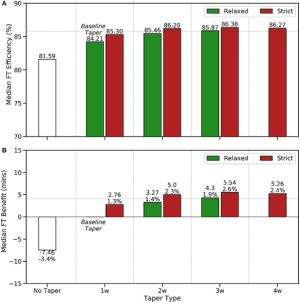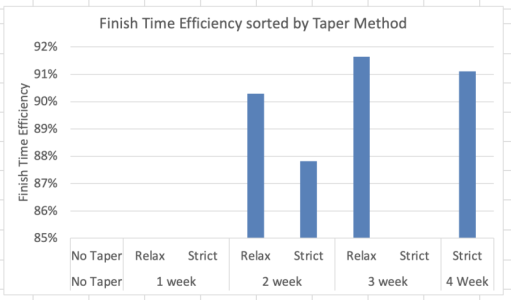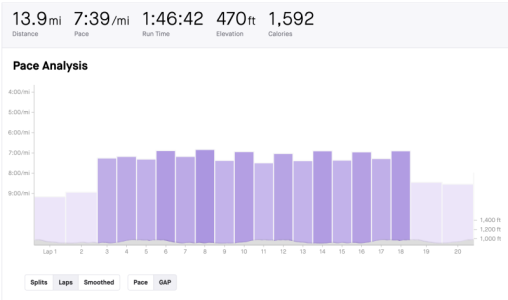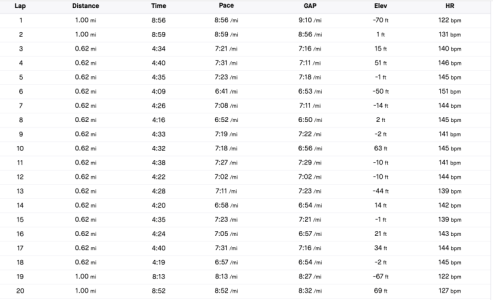DopeyBadger
Imagathoner
- Joined
- Oct 15, 2015
- Messages
- 10,374
4 Weeks to go - Canova Specific Phase - Week 6/10
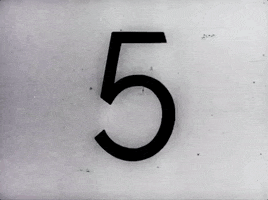
10/10/22-10/16/22
Tues (10/11): Canova Specific Extensive Endurance
Wed (10/12): 6.5 miles @ 60-70% M Tempo (9:17 min/mile, 125 bpm)
Thurs (10/13): 11 miles @ 87.5% M Tempo (7:56 min/mile, 132 bpm)
Fri (10/14): 6.5 miles @ 60-70% M Tempo (9:08 min/mile, 126 bpm)
Sat (10/15): 6.5 miles @ 60-70% M Tempo (9:20 min/mile, 120 bpm) + LIIFT4-Chest/Back
Sun (10/16): Canova Special Marathon Block on Jack/Jill - AM and PM workouts
Total Run Miles - 64.4 miles
Total Run Time - 8:41 hours
Total Strength Time - 0:30 hours
Total Training Time - 9:11 hours
Tuesday
Conditions - Clear, Wind 9mph to 19mph
Clear, Wind 9mph to 19mph
Start: Temp+Dew = 46°F + 44°F; FL - 42°F
End: Temp+Dew = 52°F + 50°F; FL - 42°F
We ended last week with a little concern about the left groin and right achilles. Although neither were of any concern during this run or any other this week. I had the day off from work for this one. So nice early morning chilly workout. I would have preferred it a little colder and with a little less wind.
4 sets of (2.5 miles at 100% M Tempo + 1km at 85-90% M Tempo)
100% M Tempo Goal Pace = 7:02 min/mile
85-90% M Tempo Goal Pace = 7:44-8:05 min/mile
No T+D adjustments allowed in Specific Phase. Would have been a 2 sec/mile effect.
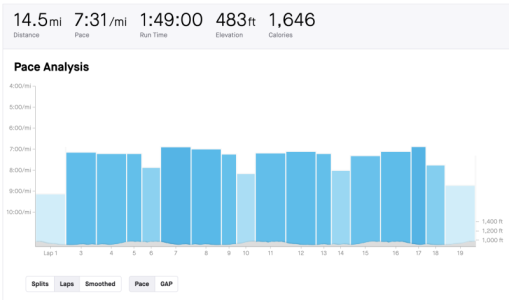
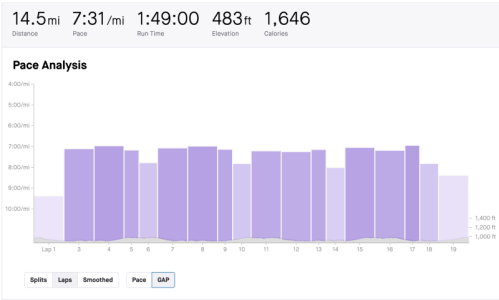
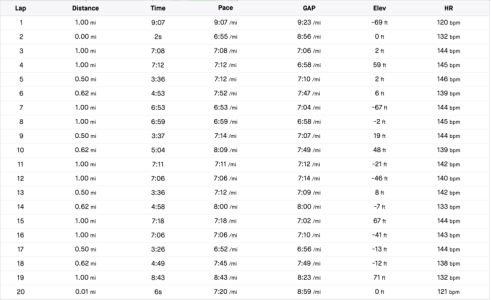
Actual Pace = 7:07 min/mile (7:11, 7:00, 7:10, 7:09) and 7:57 min/mile (7:53, 8:10, 8:01, 7:46)
Grade Adjusted Pace = 7:05 min/mile (7:04, 7:02, 7:12, 7:04) and 7:51 min/mile (7:47, 7:49, 8:00, 7:49)
I'd love to sit here and type all about this run, but honestly, I don't remember much of anything. I remember giving a solid effort level. I remember that I felt like I was floating during the last recovery interval at 7:46 pace. I also remember almost getting hit by a school bus because it took the corner a little tighter than I was expecting (jumped up on to the curve to avoid it). All in all it was a pretty solid run. The pace was a hair slower than goal, but not by much. The splits were fairly consistent. So I'll take it. In total it was 10 miles at M Tempo with an additional 2.5 miles of recovery intervals at a decent pace in between reps. So even the 12.5 miles was 7:16 min/mile pace average.
Wednesday
Conditions - Partly Cloudy, Wind 12mph to 20mph
Partly Cloudy, Wind 12mph to 20mph
Start: Temp+Dew = 56°F + 46°F; FL - 56°F
End: Temp+Dew = 54°F + 45°F; FL - 56°F
Body felt decent coming off the effort yesterday. That continues to be a trend here in the 4th phase (Specific) of the Canova cycle. In the third cycle, I was definitely coming out of the workouts feeling like a train wreck in the next workout. But my body is recovering quite well from run to run, and there's little to no massive amounts of fatigue. Certainly I don't feel like I want to run any faster, but I could if I absolutely had to. So the body and the level of difficulty of the workouts seems like a good place. Maybe they aren't hard enough? Although on paper, they're pretty hard.
Thursday
Conditions - Mostly Cloudy, Wind 12mph to 20mph
Mostly Cloudy, Wind 12mph to 20mph
Start: Temp+Dew = 44°F + 34°F; FL - 38°F
End: Temp+Dew = 41°F + 34°F; FL - 38°F
It's time to retire the blue Next% shoes (they were Madison 2021 race shoes, Princess Weekend main training shoes, and Canova moderate day shoes). So the orange Next% 2 shoes have moved from Princess Weekend 2022 race shoes, Canova main training shoes, to Canova moderate day shoes). And a new pair of red Next% 2 shoes are moving in as the new main training shoes. The blue shoes probably ended with around 1000 miles, and the orange shoes probably have like 500-600 miles on them. I could sit down and roughly calculate it. *Actually did and it comes out to about 530 miles. So they're not "race ready" anymore, but they're still performing quite well as the moderate day shoe.
Pretty sure it was this run and the next that felt essentially effortless. I was just floating along at a slightly faster pace than intended, but felt strong for almost the entire workout. Never really challenged or pressed. That's a nice feeling to have for a 11 mile 7:56 pace workout.
I wore shorts, tank top, light gloves, and no headband. I think I should have worn a headband, but other than that the outfit was good. A neighbor that I see nearly every day yelled (in a nice way) that it was probably time to put something on other than a tank top. I said, not quite yet. These temps are my wheelhouse.
Friday
Conditions - 🌧 Possible Drizzle, Wind 10mph to 18mph
Start: Temp+Dew = 44°F + 33°F; FL - 39°F
End: Temp+Dew = 42°F + 33°F; FL - 39°F
Like I said, pretty sure this run felt essentially effortless. No real pains or soreness to speak of either. Just gliding along. I wore a light long sleeve, light hat, light gloves, and shorts. I was comfortable.
Saturday
Conditions - Partly Cloudy, Wind 8mph to 16mph
Partly Cloudy, Wind 8mph to 16mph
Start: Temp+Dew = 31°F + 31°F; FL - 24°F
End: Temp+Dew = 33°F + 31°F; FL - 24°F
I wore a light long sleeve, light hat, medium gloves, and shorts. The legs were a little cold, but not too bad. The medium gloves got a little hot towards the end, but since it was an easy day I wasn't overly concerned. The run was a bit more sluggish than the last two. Not nearly as effortless. With that being said the HR was nice and low as was the effort. Just getting myself prepared for tomorrow's double.
I did the final week of LIIFT4 - Chest/Back. I cruised through the workout with the 30lb dumbbells and may need to consider moving up eventually. It's crazy how light the lower weights feel now.
Sunday
Conditions - Mostly Cloudy, Wind 7mph to 15mph
Mostly Cloudy, Wind 7mph to 15mph
Start: Temp+Dew = 38°F + 36°F; FL - 33°F
End: Temp+Dew = 40°F + 37°F; FL - 33°F
Alright, my second and last attempt at the Canova Special Marathon Block. A daily double repeat of the same workout:
35 min @ 87.5% M Tempo + 35 min @ 100% M Tempo
Optional Stimulus: Consume no carbs between workouts (I'm not doing this part)
I only drank a liquid IV and ate a nature grain bar before the run. No carbs during the run because it's under 90 min. I wore a tank top, shorts, headband, and light gloves. I was completely comfortable in this outfit at these paces. I also wore the new red Next%2 shoes.
87.5% M Tempo Goal Pace = 7:55 min/mile
100% M Tempo Goal Pace = 7:02 min/mile
No T+D adjustments allowed in Specific Phase
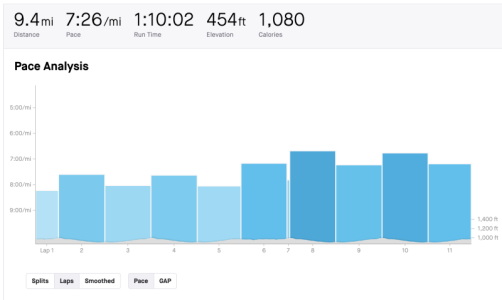
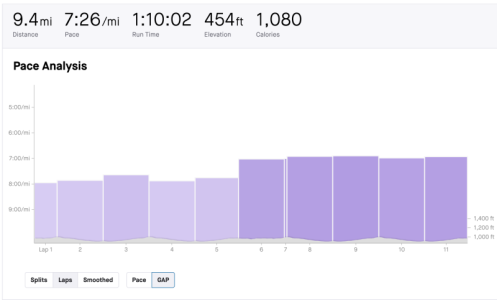
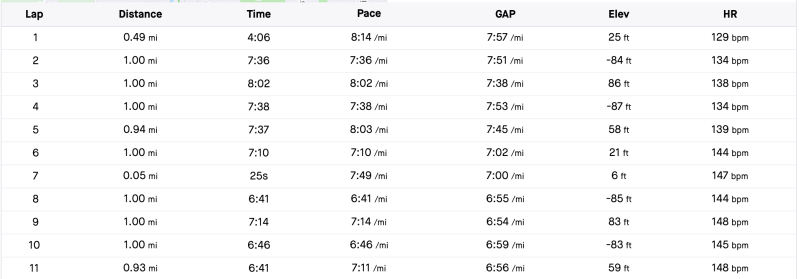
87.5% Actual Pace = 7:52 min/mile
85% Grade Adj Pace = 7:48 min/mile
100% Actual Pace = 7:02 min/mile
100% Grade Adj Pace = 6:57 min/mile
So this workout was suppose to start at 85% M Tempo. But the last few weeks, I've increased the moderate day a touch to 87.5% M Tempo. Not consciously, but that just seems to be where my body is gravitating to right now. So it didn't come as much of a surprise to see myself hovering around the 7:55 pace instead of the 8:05 pace. Question was, was it going to come back and bite me during the 100% M Tempo portion which I haven't nailed yet (although I haven't had many low 30 wind chill days fall on these hard effort workouts)? I decided to see what happens. The 87.5% pace felt about as good as expected. The new Next%2 shoes definitely had more of a pop to them. I never really felt pressed and wrapped up the 35 min in about 4.44 miles and 7:52 pace.
Then came time to throw down the hammer a bit. I increased the effort to what felt right for 100% M Tempo, and settled in for the 35 min bout. I hit the first mile at 7:10, but wasn't overly concerned because I knew it was a positive GAP mile. I was off a touch on my GAP mile markers, so I hit the lap button when I reached the top of the hill at 5.5 miles to get back on track. Then I bolted down the hill, saw a 6:40 at the half way mark of the downhill and knew I was in a good place. Hit that split at 6:41. Turned around and headed up the full hill. Hit the mid-split at 7:05 and knew I was aiming for about 7:22-7:27 so I was doing alright. Hit that split at 7:14 and knew I was a little too hot on that one. I raced back down the hill. I was focusing on my breathing and keeping my eyes up. Hit the mid-split at 6:49 and knew I was a touch behind goal. So I buckled down and really dropped the hammer a little more. I ended that split at 6:46 which was good because it meant I was able to increase the pace over that last 0.5 mile (something like 6:43 pace). I knew all I had left was to make it back home. This was a fun test because I've done this timed workout two prior times. So I should make it a little bit further if I'm going a little bit faster. So it was nice to see where I finished the run compared to the other two times. I was definitely feeling the effects of the last hill climb, but came in at 7:11 pace (6:56 GAP) which was close to target.
All in all a good run. But the day's not done yet....
****
Conditions - Overcast, Wind 13mph to 21mph
Overcast, Wind 13mph to 21mph
Start: Temp+Dew = 47°F + 37°F; FL - 41°F
End: Temp+Dew = 45°F + 36°F; FL - 41°F
Second repeat of the same workout today:
35 min @ 87.5% M Tempo + 35 min @ 100% M Tempo
Optional Stimulus: Consume no carbs between workouts (I'm not doing this part)
87.5% M Tempo Goal Pace = 7:55 min/mile
100% M Tempo Goal Pace = 7:02 min/mile
No T+D adjustments allowed in Specific Phase
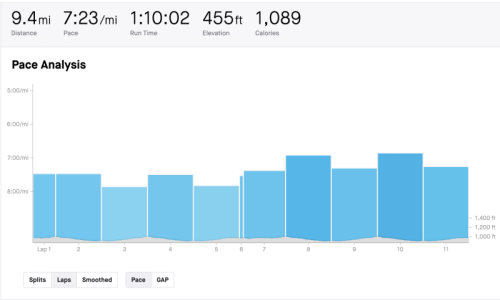
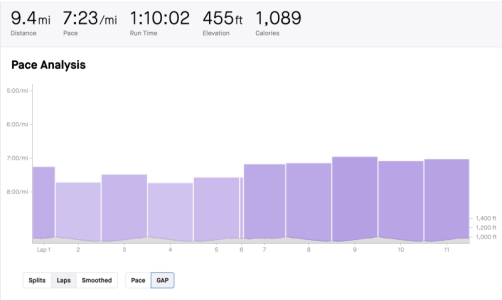
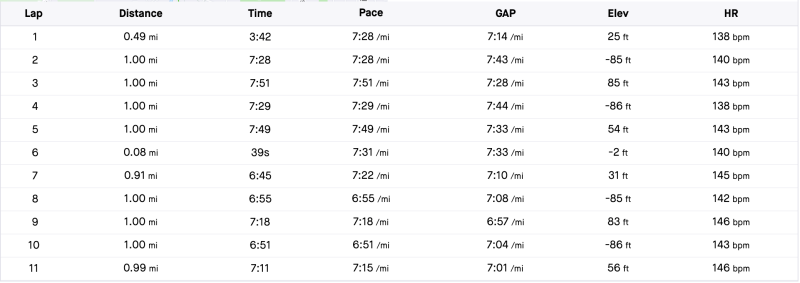
87.5% Actual Pace = 7:40 min/mile
85% Grade Adj Pace = 7:34 min/mile
100% Actual Pace = 7:08 min/mile
100% Grade Adj Pace = 7:04 min/mile
Felt way too good to start. The first 35 min felt ridiculously easy. That caught up to me in the second 35 min. Didn't help that a windy portion of weather rolled in during the second half. I fought hard for that second half 100% M Tempo. It was a little slower to start, but I rallied as the run went along and closed well.
Not much time left in the training plan now. Just the home stretch and we're on to race day. Gotta keep my head down and stay healthy. Next week only has one hard day (another Specific Intensive Endurance) and several easy/moderate days.

10/10/22-10/16/22
Tues (10/11): Canova Specific Extensive Endurance
Wed (10/12): 6.5 miles @ 60-70% M Tempo (9:17 min/mile, 125 bpm)
Thurs (10/13): 11 miles @ 87.5% M Tempo (7:56 min/mile, 132 bpm)
Fri (10/14): 6.5 miles @ 60-70% M Tempo (9:08 min/mile, 126 bpm)
Sat (10/15): 6.5 miles @ 60-70% M Tempo (9:20 min/mile, 120 bpm) + LIIFT4-Chest/Back
Sun (10/16): Canova Special Marathon Block on Jack/Jill - AM and PM workouts
Total Run Miles - 64.4 miles
Total Run Time - 8:41 hours
Total Strength Time - 0:30 hours
Total Training Time - 9:11 hours
Tuesday
Conditions -
Start: Temp+Dew = 46°F + 44°F; FL - 42°F
End: Temp+Dew = 52°F + 50°F; FL - 42°F
We ended last week with a little concern about the left groin and right achilles. Although neither were of any concern during this run or any other this week. I had the day off from work for this one. So nice early morning chilly workout. I would have preferred it a little colder and with a little less wind.
4 sets of (2.5 miles at 100% M Tempo + 1km at 85-90% M Tempo)
100% M Tempo Goal Pace = 7:02 min/mile
85-90% M Tempo Goal Pace = 7:44-8:05 min/mile
No T+D adjustments allowed in Specific Phase. Would have been a 2 sec/mile effect.



Actual Pace = 7:07 min/mile (7:11, 7:00, 7:10, 7:09) and 7:57 min/mile (7:53, 8:10, 8:01, 7:46)
Grade Adjusted Pace = 7:05 min/mile (7:04, 7:02, 7:12, 7:04) and 7:51 min/mile (7:47, 7:49, 8:00, 7:49)
I'd love to sit here and type all about this run, but honestly, I don't remember much of anything. I remember giving a solid effort level. I remember that I felt like I was floating during the last recovery interval at 7:46 pace. I also remember almost getting hit by a school bus because it took the corner a little tighter than I was expecting (jumped up on to the curve to avoid it). All in all it was a pretty solid run. The pace was a hair slower than goal, but not by much. The splits were fairly consistent. So I'll take it. In total it was 10 miles at M Tempo with an additional 2.5 miles of recovery intervals at a decent pace in between reps. So even the 12.5 miles was 7:16 min/mile pace average.
Wednesday
Conditions -
Start: Temp+Dew = 56°F + 46°F; FL - 56°F
End: Temp+Dew = 54°F + 45°F; FL - 56°F
Body felt decent coming off the effort yesterday. That continues to be a trend here in the 4th phase (Specific) of the Canova cycle. In the third cycle, I was definitely coming out of the workouts feeling like a train wreck in the next workout. But my body is recovering quite well from run to run, and there's little to no massive amounts of fatigue. Certainly I don't feel like I want to run any faster, but I could if I absolutely had to. So the body and the level of difficulty of the workouts seems like a good place. Maybe they aren't hard enough? Although on paper, they're pretty hard.
Thursday
Conditions -
Start: Temp+Dew = 44°F + 34°F; FL - 38°F
End: Temp+Dew = 41°F + 34°F; FL - 38°F
It's time to retire the blue Next% shoes (they were Madison 2021 race shoes, Princess Weekend main training shoes, and Canova moderate day shoes). So the orange Next% 2 shoes have moved from Princess Weekend 2022 race shoes, Canova main training shoes, to Canova moderate day shoes). And a new pair of red Next% 2 shoes are moving in as the new main training shoes. The blue shoes probably ended with around 1000 miles, and the orange shoes probably have like 500-600 miles on them. I could sit down and roughly calculate it. *Actually did and it comes out to about 530 miles. So they're not "race ready" anymore, but they're still performing quite well as the moderate day shoe.
Pretty sure it was this run and the next that felt essentially effortless. I was just floating along at a slightly faster pace than intended, but felt strong for almost the entire workout. Never really challenged or pressed. That's a nice feeling to have for a 11 mile 7:56 pace workout.
I wore shorts, tank top, light gloves, and no headband. I think I should have worn a headband, but other than that the outfit was good. A neighbor that I see nearly every day yelled (in a nice way) that it was probably time to put something on other than a tank top. I said, not quite yet. These temps are my wheelhouse.
Friday
Conditions - 🌧 Possible Drizzle, Wind 10mph to 18mph
Start: Temp+Dew = 44°F + 33°F; FL - 39°F
End: Temp+Dew = 42°F + 33°F; FL - 39°F
Like I said, pretty sure this run felt essentially effortless. No real pains or soreness to speak of either. Just gliding along. I wore a light long sleeve, light hat, light gloves, and shorts. I was comfortable.
Saturday
Conditions -
Start: Temp+Dew = 31°F + 31°F; FL - 24°F
End: Temp+Dew = 33°F + 31°F; FL - 24°F
I wore a light long sleeve, light hat, medium gloves, and shorts. The legs were a little cold, but not too bad. The medium gloves got a little hot towards the end, but since it was an easy day I wasn't overly concerned. The run was a bit more sluggish than the last two. Not nearly as effortless. With that being said the HR was nice and low as was the effort. Just getting myself prepared for tomorrow's double.
I did the final week of LIIFT4 - Chest/Back. I cruised through the workout with the 30lb dumbbells and may need to consider moving up eventually. It's crazy how light the lower weights feel now.
Sunday
Conditions -
Start: Temp+Dew = 38°F + 36°F; FL - 33°F
End: Temp+Dew = 40°F + 37°F; FL - 33°F
Alright, my second and last attempt at the Canova Special Marathon Block. A daily double repeat of the same workout:
35 min @ 87.5% M Tempo + 35 min @ 100% M Tempo
Optional Stimulus: Consume no carbs between workouts (I'm not doing this part)
I only drank a liquid IV and ate a nature grain bar before the run. No carbs during the run because it's under 90 min. I wore a tank top, shorts, headband, and light gloves. I was completely comfortable in this outfit at these paces. I also wore the new red Next%2 shoes.
87.5% M Tempo Goal Pace = 7:55 min/mile
100% M Tempo Goal Pace = 7:02 min/mile
No T+D adjustments allowed in Specific Phase



87.5% Actual Pace = 7:52 min/mile
85% Grade Adj Pace = 7:48 min/mile
100% Actual Pace = 7:02 min/mile
100% Grade Adj Pace = 6:57 min/mile
So this workout was suppose to start at 85% M Tempo. But the last few weeks, I've increased the moderate day a touch to 87.5% M Tempo. Not consciously, but that just seems to be where my body is gravitating to right now. So it didn't come as much of a surprise to see myself hovering around the 7:55 pace instead of the 8:05 pace. Question was, was it going to come back and bite me during the 100% M Tempo portion which I haven't nailed yet (although I haven't had many low 30 wind chill days fall on these hard effort workouts)? I decided to see what happens. The 87.5% pace felt about as good as expected. The new Next%2 shoes definitely had more of a pop to them. I never really felt pressed and wrapped up the 35 min in about 4.44 miles and 7:52 pace.
Then came time to throw down the hammer a bit. I increased the effort to what felt right for 100% M Tempo, and settled in for the 35 min bout. I hit the first mile at 7:10, but wasn't overly concerned because I knew it was a positive GAP mile. I was off a touch on my GAP mile markers, so I hit the lap button when I reached the top of the hill at 5.5 miles to get back on track. Then I bolted down the hill, saw a 6:40 at the half way mark of the downhill and knew I was in a good place. Hit that split at 6:41. Turned around and headed up the full hill. Hit the mid-split at 7:05 and knew I was aiming for about 7:22-7:27 so I was doing alright. Hit that split at 7:14 and knew I was a little too hot on that one. I raced back down the hill. I was focusing on my breathing and keeping my eyes up. Hit the mid-split at 6:49 and knew I was a touch behind goal. So I buckled down and really dropped the hammer a little more. I ended that split at 6:46 which was good because it meant I was able to increase the pace over that last 0.5 mile (something like 6:43 pace). I knew all I had left was to make it back home. This was a fun test because I've done this timed workout two prior times. So I should make it a little bit further if I'm going a little bit faster. So it was nice to see where I finished the run compared to the other two times. I was definitely feeling the effects of the last hill climb, but came in at 7:11 pace (6:56 GAP) which was close to target.
All in all a good run. But the day's not done yet....
****
Conditions -
Start: Temp+Dew = 47°F + 37°F; FL - 41°F
End: Temp+Dew = 45°F + 36°F; FL - 41°F
Second repeat of the same workout today:
35 min @ 87.5% M Tempo + 35 min @ 100% M Tempo
Optional Stimulus: Consume no carbs between workouts (I'm not doing this part)
87.5% M Tempo Goal Pace = 7:55 min/mile
100% M Tempo Goal Pace = 7:02 min/mile
No T+D adjustments allowed in Specific Phase



87.5% Actual Pace = 7:40 min/mile
85% Grade Adj Pace = 7:34 min/mile
100% Actual Pace = 7:08 min/mile
100% Grade Adj Pace = 7:04 min/mile
Felt way too good to start. The first 35 min felt ridiculously easy. That caught up to me in the second 35 min. Didn't help that a windy portion of weather rolled in during the second half. I fought hard for that second half 100% M Tempo. It was a little slower to start, but I rallied as the run went along and closed well.
Not much time left in the training plan now. Just the home stretch and we're on to race day. Gotta keep my head down and stay healthy. Next week only has one hard day (another Specific Intensive Endurance) and several easy/moderate days.



